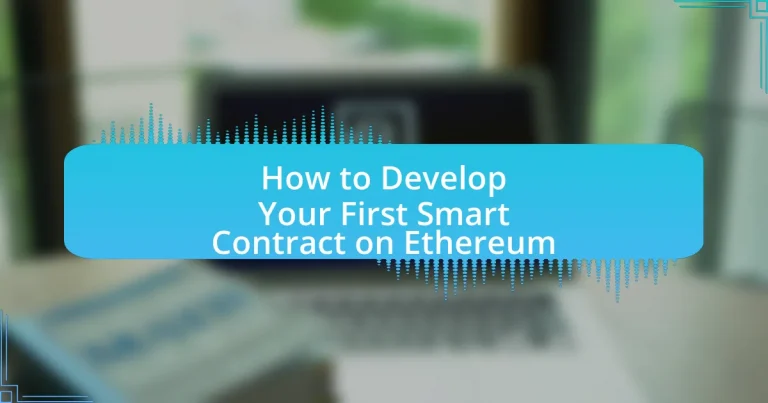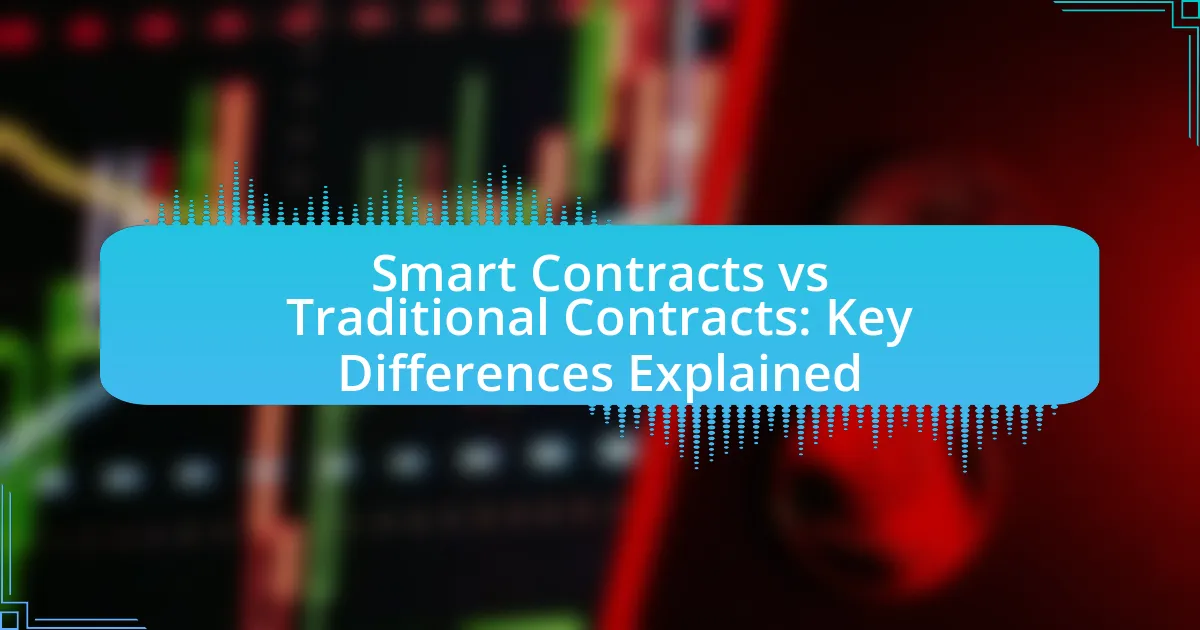The article focuses on developing a smart contract on the Ethereum blockchain, detailing the essential components, functionality, and significance of smart contracts in blockchain technology. It outlines the programming languages used, primarily Solidity, and emphasizes the importance of security, transparency, and automation in smart contracts. The article provides a step-by-step guide for setting up a development environment, writing, testing, and deploying a smart contract, while also highlighting best practices and tools necessary for effective smart contract development. Additionally, it addresses common pitfalls and resources for ongoing learning in the field.
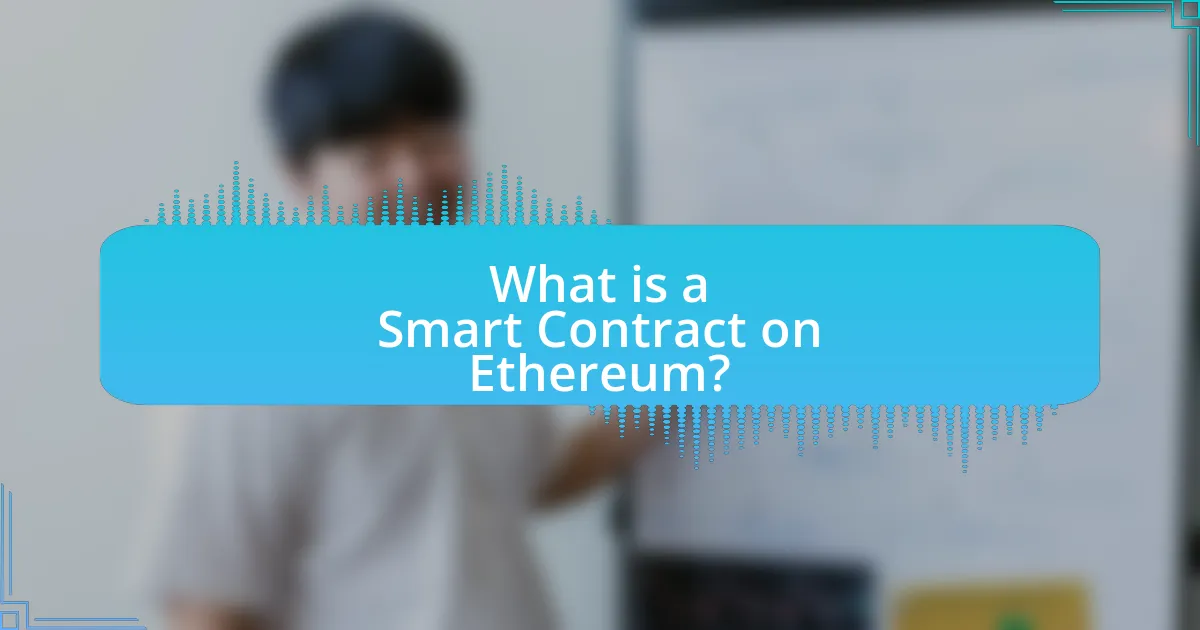
What is a Smart Contract on Ethereum?
A smart contract on Ethereum is a self-executing contract with the terms of the agreement directly written into code. These contracts run on the Ethereum blockchain, enabling automated transactions and operations without the need for intermediaries. Smart contracts are immutable and distributed, meaning once deployed, they cannot be altered, and their execution is transparent and verifiable by all participants on the network. This functionality is supported by Ethereum’s Turing-complete programming language, Solidity, which allows developers to create complex logic for various applications, such as decentralized finance (DeFi) and non-fungible tokens (NFTs).
How do Smart Contracts function within the Ethereum ecosystem?
Smart contracts function as self-executing contracts with the terms of the agreement directly written into code on the Ethereum blockchain. They automatically enforce and execute contractual agreements when predetermined conditions are met, eliminating the need for intermediaries. The Ethereum Virtual Machine (EVM) processes these contracts, allowing developers to create decentralized applications (dApps) that can interact with the blockchain. Smart contracts are immutable and transparent, meaning once deployed, they cannot be altered, and their execution is visible to all participants on the network, ensuring trust and security. This functionality is supported by Ethereum’s underlying technology, which enables complex logic and interactions through its programming language, Solidity.
What programming languages are used to write Smart Contracts?
Smart contracts are primarily written in Solidity, which is a high-level programming language specifically designed for the Ethereum blockchain. Additionally, other languages such as Vyper, which emphasizes security and simplicity, and Rust, used in the Polkadot and Solana ecosystems, are also utilized for writing smart contracts. Solidity is the most widely adopted language, with extensive documentation and community support, making it the primary choice for Ethereum developers.
What are the key components of a Smart Contract?
The key components of a Smart Contract include code, state, and events. The code defines the rules and logic of the contract, typically written in a programming language like Solidity for Ethereum. The state represents the current status of the contract, including variables that store data relevant to the contract’s execution. Events are used to log changes or actions that occur within the contract, allowing external applications to listen for and respond to these changes. These components work together to ensure that the Smart Contract operates autonomously and securely on the blockchain.
Why are Smart Contracts important in blockchain technology?
Smart contracts are important in blockchain technology because they automate and enforce agreements without the need for intermediaries. This automation reduces the risk of fraud and increases efficiency by executing transactions automatically when predefined conditions are met. For instance, Ethereum’s blockchain enables smart contracts to run code that can manage assets, execute trades, and facilitate complex agreements securely and transparently. The immutability of blockchain ensures that once a smart contract is deployed, it cannot be altered, providing trust and reliability in transactions.
How do Smart Contracts enhance security and transparency?
Smart contracts enhance security and transparency by automating and enforcing agreements through code on a blockchain. This automation reduces the risk of human error and fraud, as the terms of the contract are executed exactly as programmed without the need for intermediaries. Additionally, the decentralized nature of blockchain technology ensures that all transactions are recorded in a tamper-proof manner, making them publicly verifiable. For instance, Ethereum’s blockchain allows anyone to audit the smart contract’s code and transaction history, thereby increasing trust among parties involved.
What advantages do Smart Contracts offer over traditional contracts?
Smart contracts offer advantages over traditional contracts primarily through automation, security, and efficiency. Automation eliminates the need for intermediaries, allowing transactions to execute automatically when predefined conditions are met, which reduces time and costs associated with contract enforcement. Security is enhanced as smart contracts are stored on a blockchain, making them tamper-proof and resistant to fraud; for instance, Ethereum’s blockchain employs cryptographic techniques that ensure data integrity. Additionally, efficiency is improved due to the reduction of paperwork and manual processes, enabling faster transaction times. These advantages collectively lead to a more streamlined and reliable contracting process compared to traditional methods.
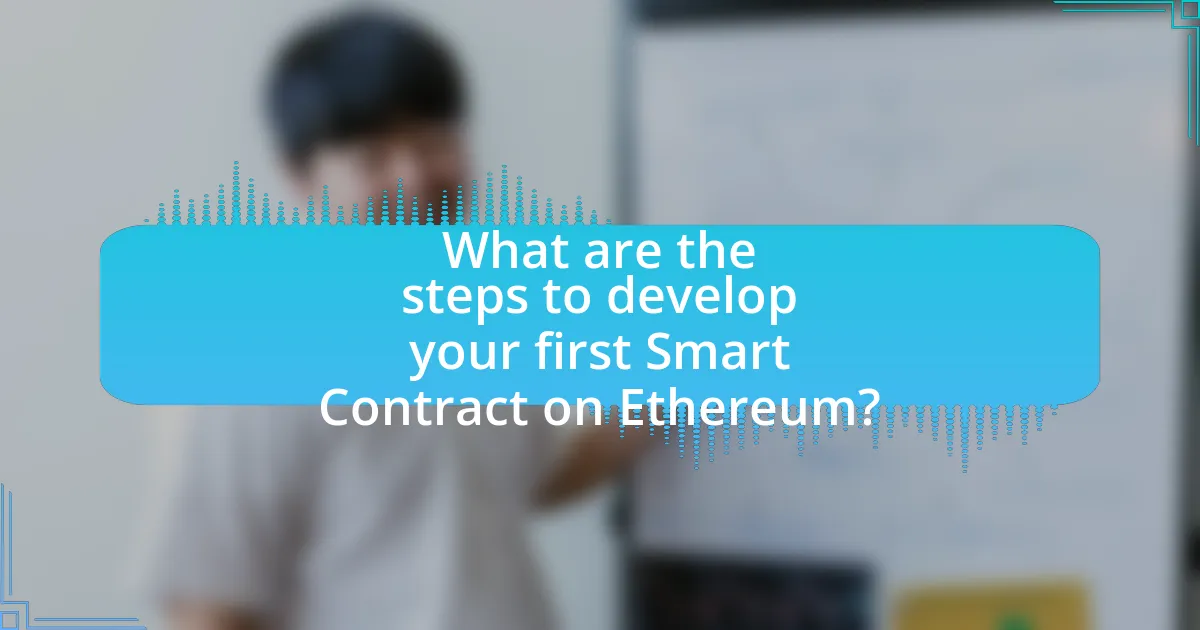
What are the steps to develop your first Smart Contract on Ethereum?
To develop your first Smart Contract on Ethereum, follow these steps: First, set up your development environment by installing Node.js and npm, then install Truffle, a popular development framework for Ethereum. Next, create a new Truffle project using the command “truffle init,” which sets up the necessary directory structure. After that, write your Smart Contract in Solidity, the programming language for Ethereum, and save it in the “contracts” directory. Compile the Smart Contract using the command “truffle compile,” which checks for errors and prepares it for deployment. Then, configure the deployment settings in the “migrations” directory and deploy the Smart Contract to the Ethereum network using “truffle migrate.” Finally, interact with your deployed Smart Contract using Truffle Console or a front-end application. These steps are validated by the widespread use of Truffle in the Ethereum development community, which simplifies the process of Smart Contract creation and deployment.
How do you set up your development environment for Smart Contracts?
To set up your development environment for Smart Contracts, install Node.js and npm, then use Truffle or Hardhat as your framework. Node.js provides the runtime for executing JavaScript code, while npm allows you to manage packages. Truffle and Hardhat are popular frameworks that facilitate the development, testing, and deployment of Smart Contracts on Ethereum.
After installing Node.js, you can install Truffle by running the command “npm install -g truffle” or Hardhat with “npm install –save-dev hardhat”. These frameworks come with built-in tools for compiling contracts, running tests, and deploying to the Ethereum network. Additionally, you should set up a local blockchain environment using Ganache, which simulates the Ethereum blockchain for testing purposes.
This setup is validated by the widespread use of these tools in the Ethereum developer community, as evidenced by numerous tutorials and documentation available on their official websites.
What tools and software are necessary for Smart Contract development?
The necessary tools and software for Smart Contract development include Solidity, Remix IDE, Truffle Suite, Ganache, and MetaMask. Solidity is the primary programming language used for writing smart contracts on the Ethereum blockchain. Remix IDE is a web-based development environment that allows developers to write, test, and deploy smart contracts easily. Truffle Suite provides a comprehensive framework for developing, testing, and deploying smart contracts, while Ganache serves as a personal Ethereum blockchain for testing purposes. MetaMask is a browser extension that enables users to interact with the Ethereum blockchain and manage their accounts. These tools collectively facilitate the entire smart contract development process, ensuring efficiency and effectiveness.
How do you install and configure the Ethereum development framework?
To install and configure the Ethereum development framework, you should first install Node.js, which is required for running the framework. After installing Node.js, you can install the Truffle framework by running the command “npm install -g truffle” in your terminal. This command globally installs Truffle, a popular Ethereum development framework.
Next, you need to create a new directory for your project and navigate into it using “mkdir myproject && cd myproject”. Then, initialize a new Truffle project by executing “truffle init”, which sets up the necessary project structure and configuration files.
To configure the framework, you can edit the “truffle-config.js” file to specify network settings, compiler options, and other configurations relevant to your development environment. This setup allows you to compile, deploy, and test smart contracts on Ethereum.
What is the process of writing a Smart Contract?
The process of writing a Smart Contract involves several key steps. First, a developer defines the contract’s purpose and the rules it will enforce, ensuring clarity on its functionality. Next, the developer writes the Smart Contract code, typically using a programming language like Solidity, which is specifically designed for Ethereum. After coding, the developer tests the Smart Contract in a controlled environment, such as a testnet, to identify and fix any bugs or vulnerabilities. Once testing is complete, the developer deploys the Smart Contract to the Ethereum blockchain, making it accessible for execution. Finally, the developer monitors the Smart Contract post-deployment to ensure it operates as intended and to address any issues that may arise. This structured approach ensures the Smart Contract is reliable and secure, which is critical given the immutable nature of blockchain technology.
How do you define the structure and functions of your Smart Contract?
The structure of a Smart Contract is defined by its code, which is typically written in Solidity for Ethereum, and consists of state variables, functions, and events. State variables store the contract’s data, functions define the contract’s behavior and logic, and events allow for logging and communication with external applications. The functions can include modifiers for access control, constructors for initialization, and various business logic implementations, ensuring that the contract operates as intended. This structure is validated by the Ethereum Virtual Machine (EVM), which executes the code and enforces the rules defined within the Smart Contract, ensuring security and reliability in transactions.
What best practices should you follow while coding your Smart Contract?
To ensure the security and efficiency of your Smart Contract, follow best practices such as thorough testing, code audits, and using established design patterns. Thorough testing involves unit tests and integration tests to verify functionality and identify vulnerabilities. Code audits by experienced developers can uncover potential security flaws, as evidenced by the high-profile hacks in the Ethereum ecosystem, which often stemmed from overlooked vulnerabilities. Utilizing established design patterns, like the Checks-Effects-Interactions pattern, helps prevent common pitfalls such as reentrancy attacks. Adhering to these practices significantly reduces the risk of errors and enhances the reliability of your Smart Contract.
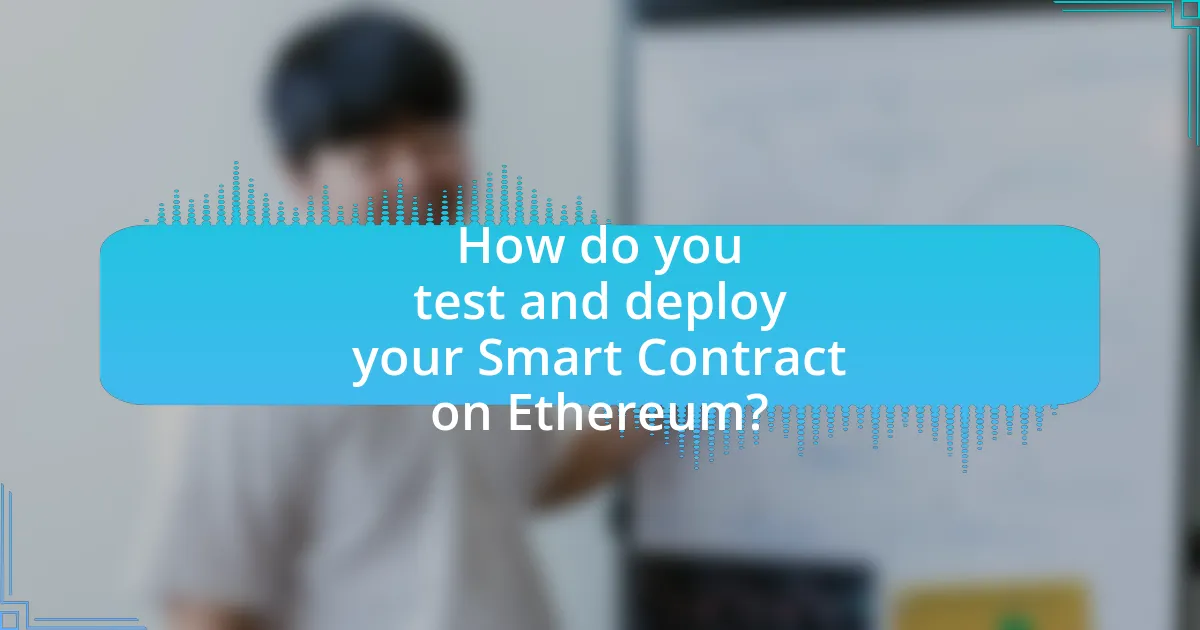
How do you test and deploy your Smart Contract on Ethereum?
To test and deploy a Smart Contract on Ethereum, developers typically use frameworks like Truffle or Hardhat. These frameworks provide tools for writing tests in JavaScript or Solidity, allowing developers to simulate contract interactions and verify functionality before deployment. For instance, Truffle enables the creation of a development environment where contracts can be tested against a local blockchain, ensuring that all functions behave as expected.
Once testing is complete, deployment involves compiling the Smart Contract and using a deployment script to send it to the Ethereum network. This process requires an Ethereum wallet with sufficient Ether to cover gas fees. After deployment, the contract’s address is recorded, allowing users to interact with it on the Ethereum blockchain. The deployment process can be verified through block explorers like Etherscan, which confirm the transaction and the contract’s existence on the network.
What testing frameworks can you use for Smart Contracts?
You can use several testing frameworks for Smart Contracts, including Truffle, Hardhat, and Brownie. Truffle is widely recognized for its comprehensive suite of tools that facilitate the development, testing, and deployment of Ethereum-based applications. Hardhat offers a flexible environment for Ethereum development, allowing for advanced testing capabilities and debugging. Brownie is specifically designed for Python developers, providing a robust framework for testing and deploying Smart Contracts. Each of these frameworks supports automated testing, enabling developers to ensure the reliability and security of their Smart Contracts effectively.
How do you write and execute test cases for your Smart Contract?
To write and execute test cases for a Smart Contract, developers typically use a testing framework like Truffle or Hardhat. These frameworks allow developers to write tests in JavaScript or Solidity, enabling them to simulate contract interactions and verify expected outcomes. For instance, a developer can create a test file that includes various scenarios, such as checking if a function correctly updates the state or if it reverts under certain conditions.
Executing these tests involves running a command in the terminal, such as “truffle test” or “npx hardhat test,” which compiles the contracts and runs the specified test cases against a local blockchain environment. This process ensures that the Smart Contract behaves as intended before deployment. The effectiveness of this approach is supported by the fact that automated testing can catch bugs early, reducing the risk of vulnerabilities in deployed contracts.
What are common pitfalls to avoid during testing?
Common pitfalls to avoid during testing include inadequate test coverage, which can lead to undetected bugs, and failing to test edge cases, resulting in unexpected behavior under unusual conditions. Additionally, not using automated testing tools can slow down the testing process and increase the likelihood of human error. Another significant pitfall is neglecting to test for security vulnerabilities, which can expose the smart contract to attacks. According to a report by ConsenSys, 70% of smart contracts have vulnerabilities that could be exploited if not properly tested. Therefore, ensuring comprehensive test coverage, utilizing automated tools, and prioritizing security testing are essential to avoid these common pitfalls.
How do you deploy your Smart Contract to the Ethereum network?
To deploy your Smart Contract to the Ethereum network, you must use a development environment like Remix, Truffle, or Hardhat, and connect to an Ethereum node via a wallet such as MetaMask. The process involves compiling the Smart Contract code, creating a transaction that includes the compiled bytecode, and sending this transaction to the Ethereum network. Once the transaction is confirmed, the Smart Contract is deployed at a unique address on the blockchain. This method is validated by the Ethereum documentation, which outlines the steps for deploying contracts using various tools and emphasizes the importance of transaction confirmation for successful deployment.
What steps are involved in deploying a Smart Contract?
The steps involved in deploying a Smart Contract include writing the contract code, compiling the code, deploying it to the blockchain, and verifying the deployment. First, developers write the Smart Contract using a programming language like Solidity. Next, they compile the code using a tool such as Remix or Truffle, which converts the code into bytecode that can be executed on the Ethereum Virtual Machine (EVM). After compilation, the bytecode is deployed to the Ethereum blockchain using a wallet or deployment tool, which requires a transaction fee paid in Ether. Finally, developers verify the deployment by checking the contract address on a blockchain explorer, ensuring that the contract is live and functioning as intended.
How do you interact with your deployed Smart Contract?
You interact with your deployed Smart Contract primarily through a web3 interface, such as a JavaScript library like Web3.js or Ethers.js. These libraries allow you to connect to the Ethereum blockchain, enabling you to send transactions, call functions, and read data from the Smart Contract. For example, using Web3.js, you can create an instance of your Smart Contract by providing its ABI (Application Binary Interface) and address, which facilitates interaction with its methods. This method of interaction is validated by the fact that these libraries are widely used in the Ethereum development community and are documented in resources such as the Ethereum Developer Documentation.
What are some best practices for Smart Contract development?
Best practices for Smart Contract development include thorough testing, code audits, and following established design patterns. Thorough testing ensures that the contract behaves as expected under various conditions, reducing the risk of bugs. Code audits by experienced developers help identify vulnerabilities and improve security, as evidenced by the high-profile hacks of poorly audited contracts, such as the DAO hack in 2016, which resulted in a loss of $60 million. Additionally, adhering to established design patterns, like the Checks-Effects-Interactions pattern, minimizes risks associated with reentrancy attacks. These practices collectively enhance the reliability and security of Smart Contracts on Ethereum.
How can you ensure the security of your Smart Contract?
To ensure the security of your Smart Contract, conduct thorough code audits and utilize formal verification methods. Code audits involve reviewing the Smart Contract’s code for vulnerabilities and logical errors, which can prevent exploits. Formal verification mathematically proves the correctness of the code against its specifications, ensuring that it behaves as intended under all conditions. According to a study by the Ethereum Foundation, 70% of Smart Contracts contain vulnerabilities, highlighting the importance of these security measures.
What resources are available for ongoing learning in Smart Contract development?
Resources available for ongoing learning in Smart Contract development include online courses, documentation, and community forums. Platforms like Coursera and Udemy offer structured courses on Ethereum and Smart Contract programming, while the Ethereum Foundation provides comprehensive documentation and tutorials. Additionally, GitHub repositories and forums such as Stack Overflow and Reddit’s r/ethdev serve as valuable community resources for troubleshooting and sharing knowledge. These resources are widely recognized in the developer community for their quality and relevance, ensuring that learners can stay updated with the latest practices and technologies in Smart Contract development.












